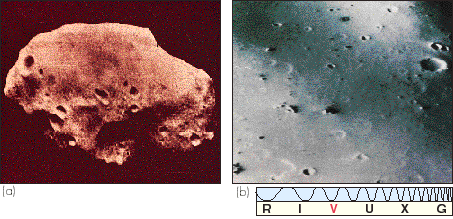Unlike Earth's moon, Mars's moons are tiny compared with their parent planet and orbit very close to it, relative to the planet's radius. Discovered by American astronomer Asaph Hall in 1877, the two Martian moons—Phobos and Deimos—are only a few kilometers across. Their composition is quite unlike that of the planet. Astronomers generally believe that Phobos and Deimos did not form along with Mars but instead are asteroids that were slowed and captured by the outer fringes of the early Martian atmosphere (which, as we have just seen, was probably much denser than the atmosphere today). It is even possible that they are remnants of a single object that broke up during the capture process. They are quite difficult to study from Earth because their proximity to Mars makes it hard to distinguish them from their much brighter parent. The Mariner and Viking orbiters, however, studied them in great detail.
Both moons, shown in Figure 10.17, are quite irregularly shaped and heavily cratered. The larger of the two is Phobos (Figure 10.17a), which is about 28 km long and 20 km wide and dominated by an enormous 10-km-wide crater named Stickney (after Angelina Stickney, Asaph Hall's wife, who encouraged him to persevere in his observations). The smaller Deimos (Figure 10.17b) is only 16 km long by 10 km wide. Its largest crater is 2.3 km in diameter. The fact that both moons have quite dark surfaces, reflecting no more than 6 percent of the light falling on them, contributes to the difficulty in observing them from Earth.

Figure 10.17 Mars is accompanied in its trek around the Sun by two tiny moons. Phobos (Greek for "fear") and Deimos ("panic") measure about 28 and 16 km long, respectively. Both are shaped like potatoes, with lots of cratering. (a) This is a Mariner 9 photograph of the irregularly shaped Phobos, not much larger than Manhattan Island. (b) Like Phobos, the smaller moon, Deimos, has a composition unlike that of Mars. Both moons are probably captured asteroids. This photograph was taken by the Viking orbiter. The field of view is only 2 km across, with most of the boulders shown about the size of a house.
Phobos and Deimos move in circular, equatorial orbits, and they rotate synchronously (that is, they keep the same face permanently turned toward the planet). All these characteristics are direct consequences of the tidal influence of Mars. Both moons orbit Mars in the prograde sense—that is, in the same sense (counterclockwise, as seen from above the north celestial pole) as the planet orbits the Sun and rotates on its axis.
Phobos lies only 9378 km (less than three planetary radii) from the center of Mars and, as we saw earlier, has an orbital period of 7 hours and 39 minutes. This orbit period is much less than a Martian day, so an observer standing on the Martian surface would see Phobos move "backward" across the Martian sky—that is, in a direction opposite the apparent daily motion of the Sun. Because the moon moves faster than the observer, it overtakes the planet's rotation, rising in the west and setting in the east, crossing the sky from horizon to horizon in about 5.5 hours. Deimos lies somewhat farther out, at 23,459 km, or slightly less than seven planetary radii, and orbits in 30 hours and 18 minutes. Because it completes its orbit in more than a Martian day, it moves "normally," as seen from the ground (that is, from east to west), taking almost 3 days to traverse the sky.
On the basis of measurements of their gravitational effect on the Viking orbiters, astronomers have estimated the masses of the two moons. Their densities are around 2000 kg/m3, far less than that of any world we have yet encountered in our outward journey through the solar system. This is an important reason why astronomers do not believe these moons formed along with Mars. If they are indeed captured asteroids, Phobos and Deimos represent material left over from the earliest stages of the solar system. Astronomers study them not to gain insight into Martian evolution but rather because the moons contain information about the very early solar system, before the major planets had formed.